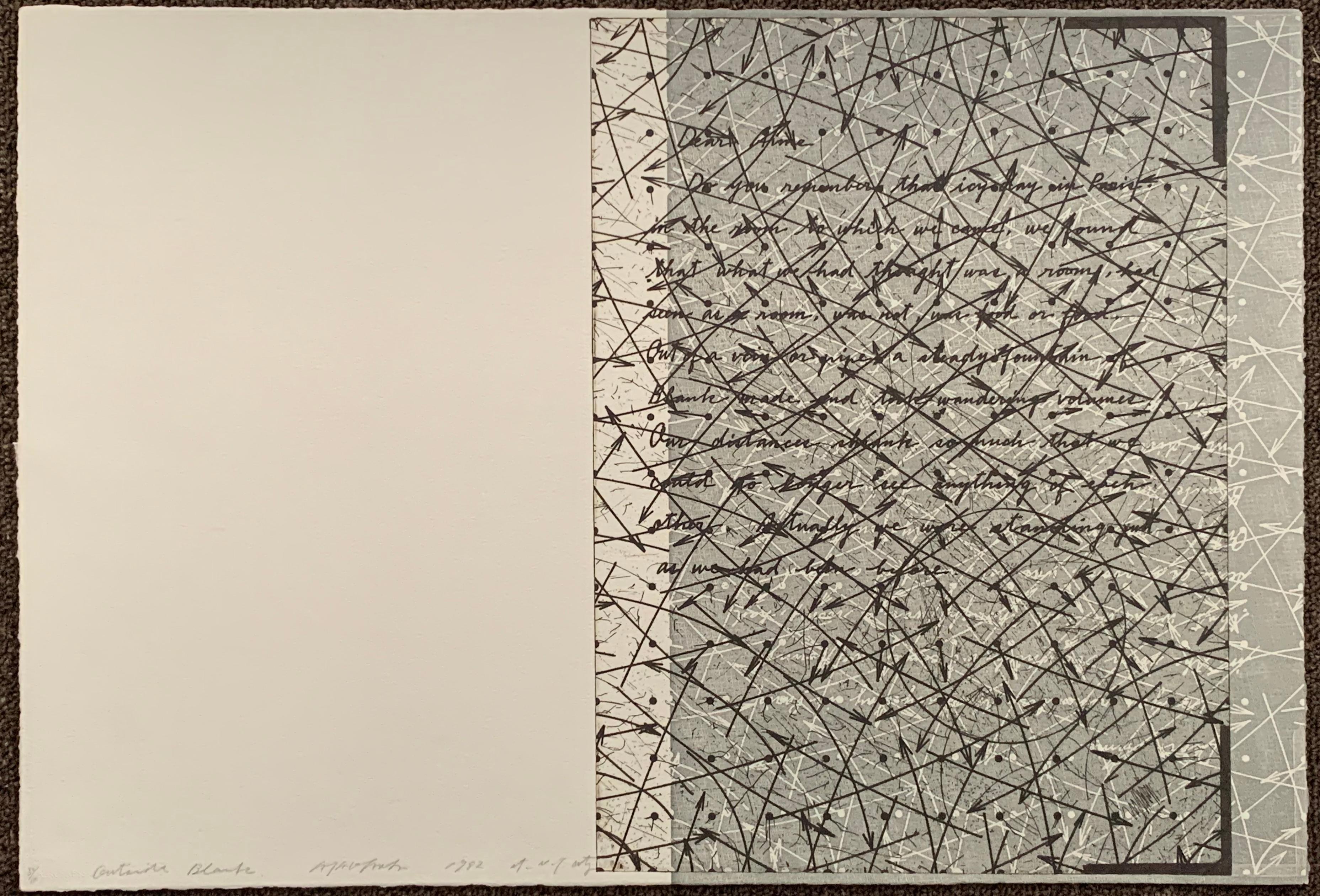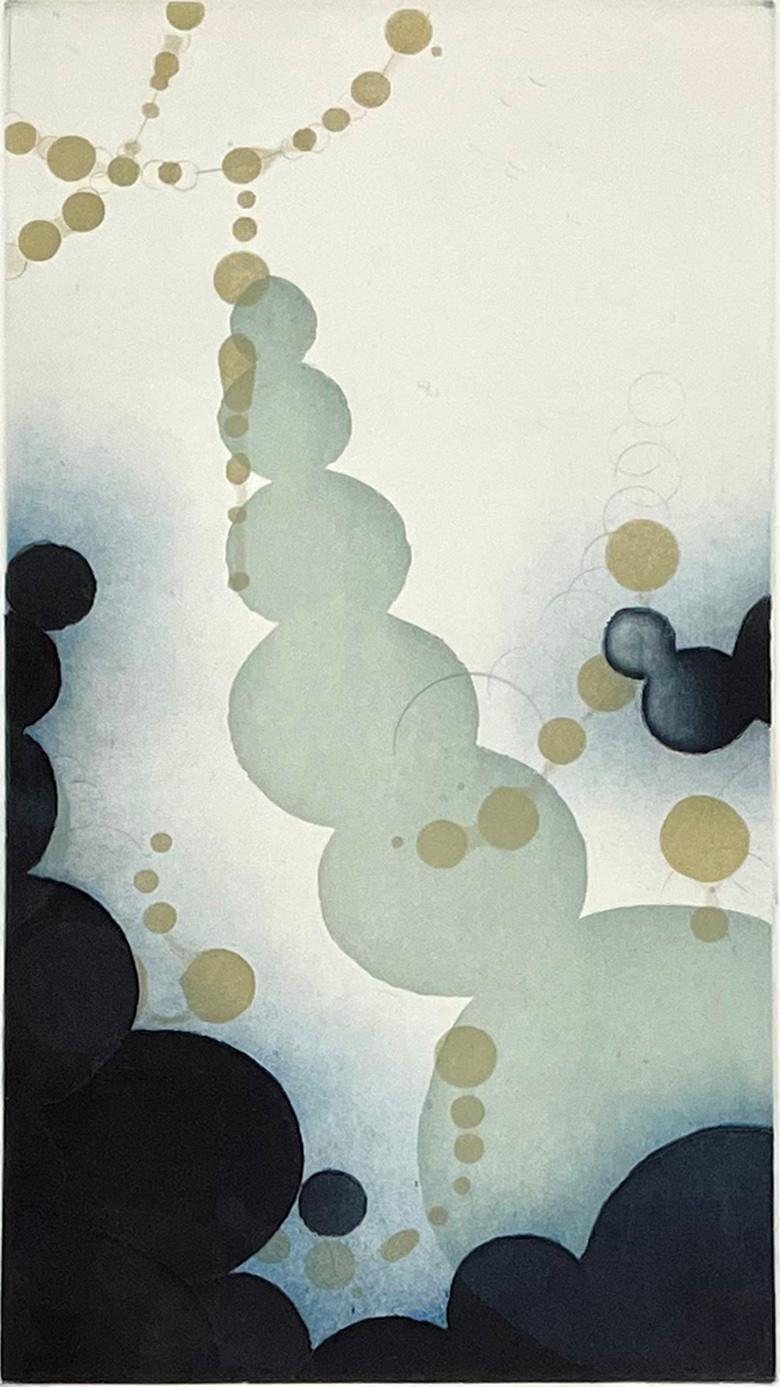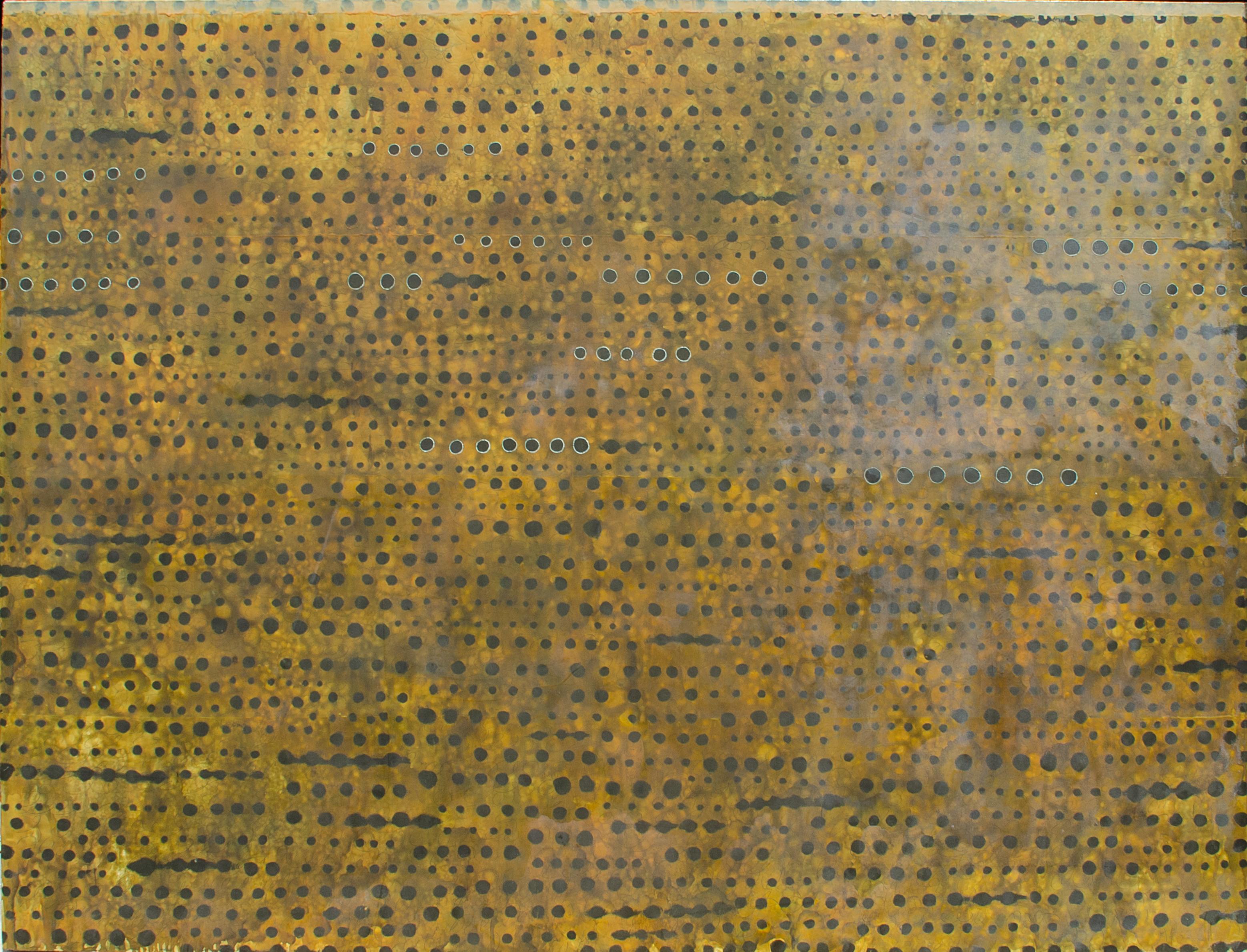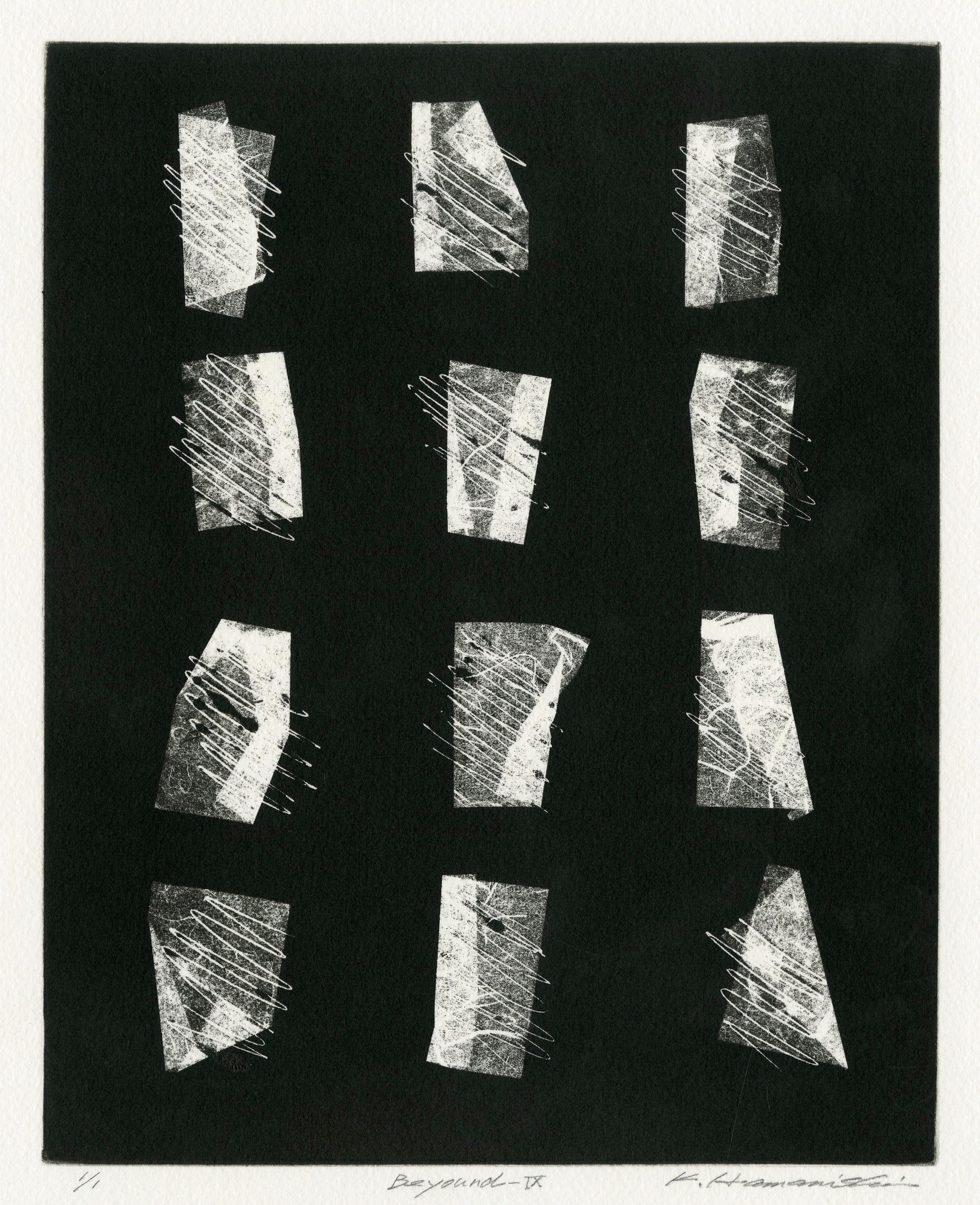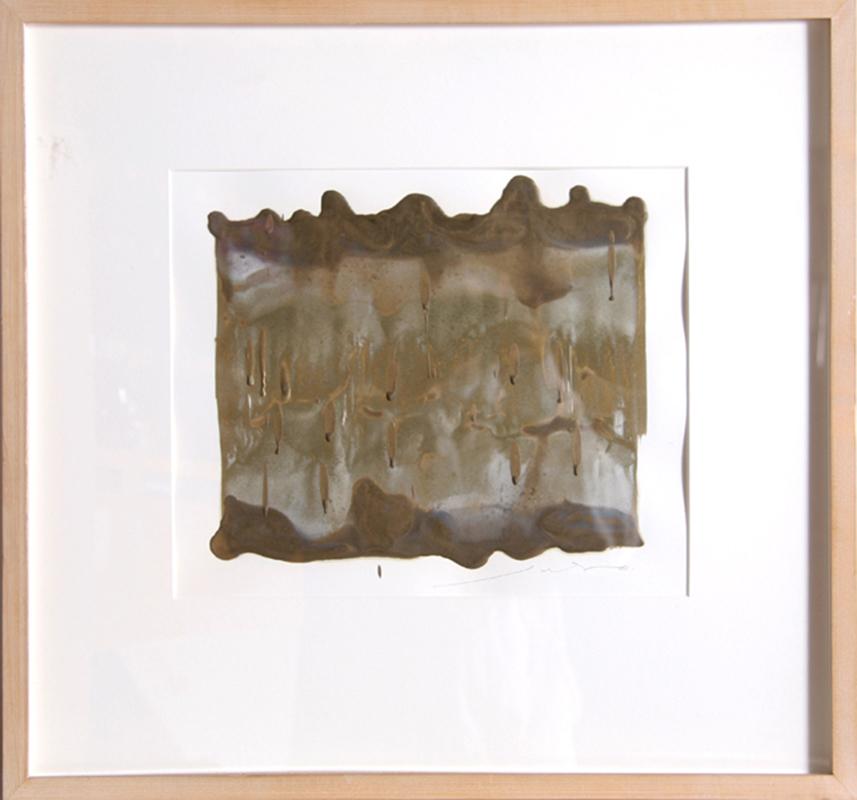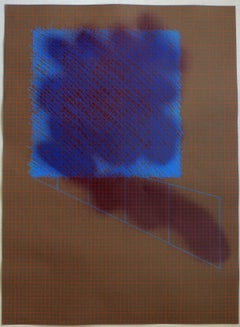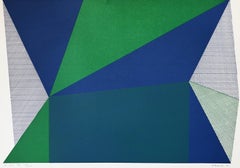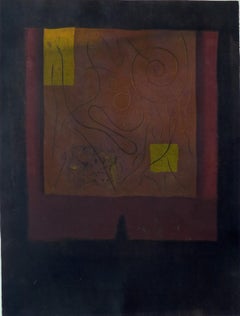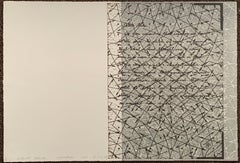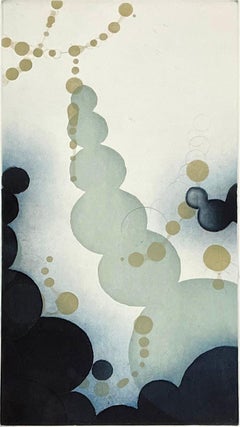Items Similar to 96-C-1
Want more images or videos?
Request additional images or videos from the seller
1 of 12
Yutaka Yoshinaga96-C-1
$950
£736.75
€838.16
CA$1,359.32
A$1,485.17
CHF 781.11
MX$17,855.46
NOK 9,834.83
SEK 9,233.61
DKK 6,258.69
About the Item
Artist: Yutaka Yoshinaga – Japanese (1948- )
Title: 96-C-1
Year: 1996
Medium: Color spit bite aquatint with drypoint and hard ground etching.
Image size: 13¾ x 9½"
Paper size: 19¼ x 15¾". Thick handmade washi paper
Framed size: 21 ½” x 18 ½”
Edition 40. This one: TPB
Publisher: Crown Point Press
Printer: Paul Mullowney
Condition: Excellent
Frame: Framed in black wood frame. Floating. Archival mounts.
This abstract print has rich saturated colors that are proabably the result of the aquatint process. It is in excellent condition. The frame and Plexiglas are in very good condition.
Yutaka Yoshinaga has been described as “one of Japan’s most renowned artists who [focuses] on two-dimensional works on paper.” Born in Nagasaki in 1948, he is currently based in Tokyo. He studied at the Suidobata Institute of Art from 1966 to 1967 and the Funabashi Institute of Fine art from 1967 to 1968, and later taught in the visual art department of the Chiyoda School of Design. He is known for his use of pigment or pastel on washi, a type of traditional handmade Japanese paper. As a 1995 review in The Wise Collection newsletter reports “Yoshinaga produces astonishing effects that please the eye and encourage quiet contemplation.”
Yoshinaga creates large colorful grids made up of rectangular sections that vary in pigment concentration. To create the grids, he begins by folding a sheet of washi paper, typically so large as to involve his entire body in the process. He works one square at a time, adding layers of color by rubbing dry pigment into the paper to create different gradients with an “accumulation of touch.” The rubbing process wears down the washi paper until it eventually becomes frayed at the seams and the fibers unravel; the paper has a soft suede-like texture. “The beauty of this medium can be realized best when the characteristics of the Japanese paper are camouflaged,” Yoshinaga wrote in an exhibition catalogue published in 1989. “I just let myself be guided by the paper’s unpredictable behavior.”
Yoshinaga’s work is associated with a style called post-mono-ha. Mono-ha means “school of things” and the movement emerged in Tokyo in the mid-1960s, rejecting traditional ideas of representation and the values of Western modern art. The artists of the mono-ha movement used natural as well as industrial materials, including glass, light bulbs, cotton, paper, wood, rope, and water. Yoshinaga emphasizes material in his work by focusing on its physicality rather than its beauty. “These works are handmade,” Yoshinaga explained. “They are about my relationship to material and to time.”
In 1996, Yoshinaga worked in the Crown Point Press studio and made etchings in a similar fashion to his works on paper. First, he laid uneven aquatint grounds on copper plates that were then submerged in acid baths overnight; the acid bit the plates in deep variations to hold ample ink. To create more texture, he drew marks using soft ground etching and drypoint. In printing, he placed the plates together on the press bed to form a large grid. The finished prints are bold in form and color, signature to his style.
Yutaka Yoshinaga has shown in exhibitions throughout Japan, the United States, Mexico, Sweden, and Korea. His work is in the collections of the Rio de Janeiro Museum of Modern Art in Brazil; the National Gallery of Art in Washington, D.C; the Fine Arts Museums of San Francisco; and the Loft Museum of Contemporary Art in Japan. He lives in Tokyo, Japan.
Source –Crown Point Press - Carleigh Koger
- Creator:Yutaka Yoshinaga (1948)
- Dimensions:Height: 21.5 in (54.61 cm)Width: 18.5 in (46.99 cm)Depth: 1.5 in (3.81 cm)
- Medium:
- Movement & Style:
- Period:
- Condition:It is in excellent condition. The frame and Plexiglas are in very good condition.
- Gallery Location:San Francisco, CA
- Reference Number:Seller: PM06062020-21stDibs: LU66636287002
About the Seller
5.0
Platinum Seller
Premium sellers with a 4.7+ rating and 24-hour response times
Established in 1999
1stDibs seller since 2017
853 sales on 1stDibs
Typical response time: 1 hour
- ShippingRetrieving quote...Shipping from: San Francisco, CA
- Return Policy
Authenticity Guarantee
In the unlikely event there’s an issue with an item’s authenticity, contact us within 1 year for a full refund. DetailsMoney-Back Guarantee
If your item is not as described, is damaged in transit, or does not arrive, contact us within 7 days for a full refund. Details24-Hour Cancellation
You have a 24-hour grace period in which to reconsider your purchase, with no questions asked.Vetted Professional Sellers
Our world-class sellers must adhere to strict standards for service and quality, maintaining the integrity of our listings.Price-Match Guarantee
If you find that a seller listed the same item for a lower price elsewhere, we’ll match it.Trusted Global Delivery
Our best-in-class carrier network provides specialized shipping options worldwide, including custom delivery.More From This Seller
View AllUntitled- Abstract Grid
By Richard Smith
Located in San Francisco, CA
Artist: Richard Smith, CBE (1931-2016) British
Title: Untitled Abstract Grid
Date: 1972
Medium: Serigraph (screenprint)
Sheet size: 29.5 in x 22 in
Framed size: 36.75 x 28.25 inches
...
Category
1970s Abstract Geometric Abstract Prints
Materials
Paper, Screen
To and Fro
By Jean-Marie Haessle
Located in San Francisco, CA
Artist: Jean-Marie Haessle - French/American (1939-)
Title: To and Fro
Year: 1980
Medium: Screen Print
Sight size: 20 x 26 inches.
Sheet size: 23 x 29 inches.
Signature: Signed lower right
Edition: 295 This one: 82/295
Condition: Very good
Unframed
This bold abstract geometric print is by the well-known French/American artist, Jean-Marie Haessle (1939- ). It is in very good, never-framed condition with no flaws to note.
Jean Marie Haessle was born in Buhl, Haut-Rhin, France. After living for a few years in Paris, he moved to New York City in 1967 where he still works and lives in his studio on Spring Street in Soho. Over the years, he had numerous shows in the US, New York, Miami, Texas and California, France and Italy (see the resume). In the mid-80’s he worked for a period in France (Paris, Lyon, and Cannes). In the late 90’s he worked in Mexico (San Miguel de Allende) where he had a one person show in 1997 in the Museo de Art in Queretaro. He had a survey exhibition of the last 30 years of his work at the Korean University Museum, Seoul, Korea in spring 2014 and a major one person show in the Namu Modern &Contemporary gallery in Seoul in September of the same year. In September 2016 he had a sold out show at the Wada Garou gallery in Tokyo, Japan. In recent years, he had numerous shows in Korea, Seoul and Busan as well as in Japan, Tokyo, Kyoto, and Osaka.
One-Person Exhibitions
2021 Mizuma, Kips Gallery New York, USA
2020 Shijimi Gallery and Wada Garou, Tokyo, Japan
Mizuma, Kips Gallery New York, USA
Keumsan Gallery, Seoul, Korea
2019 Mizuma, Kips & Wada Art, New York, USA
2018 Wada Garou, Tokyo, Japan
Superior Gallery, Gangnam Seoul Korea
2017 Foley Gallery, New York, USA
KOUDOURAN, Kyoto, Japan
2016 Wada Garou Gallery, Tokyo, Japan
2015 Soohoh Gallery, Korea
Kips Gallery New York, USA
2014 Paintings 1983 – 2013, Korea University Museum, Seoul, Korea
NaMu Modern & Contemporary, Seoul, Korea
2013 Wada Garou Gallery Tokyo, Japan
Keumsan Gallery, Seoul, Korea
2012 Hillwood Art Museum, LIU Post, NU USA
Gallery Wooduk. Seoul Korea
SOOHOH Gallery, Seoul, Korea
bcs Gallery, Long Island City, NY, USA
2011 Chantal Bamberger Galerie, Strasbourg, France
Whitelabs Gallery, Milan, Italy
Kips Gallery New York, NY USA
2010 David Richard Contemporary, Santa Fe NM, USA
Gallery AKA Space, Seoul Korea
Gallery One Tokyo, Japan
2009 Kips Gallery New York, NY USA
La Minoterie Penze, France
2008 Galerie Claire Gastaud, Clermont-Ferrand, France
Kips Gallery, New York, NY USA
2007 Kips Gallery, New York, NY USA
2000 Gallery Yvonamor Palix, Mexico DF Mexico
1997 Galerie Gastaud & Caillard, Paris France
Galerie Prebet, Roanne France
Galerie de la Tour, Altkirch France
Ecole des Beaux Arts de Metz, Metz France
Kunsthous Santa Fe, San Miguel de Allende Mexico
Museo de Art, Queretaro Mexico
Museo Regional de Tlaxcala, Tlaxcala Mexico
1996 Kim Foster Gallery, New York NY USA
Galerie Gastaud, Clermont-Ferrand France
1995 Kim Foster Gallery, New York NY USA
Galerie Gastaud & Caillard, Paris France
Center Europeen d'action Artistiques Contemporaines, Strasbourg France
Galerie Athisma, Lyon France
1994 Chateau du Grand Jardin, Joinville France
1993 Galerie Catherine Fletcher, Paris France
1991 Galerie Gastaud, Clermont-Ferrand France
Galerie Athisma, Lyon France
1989 FCI Institut, New York NY USA
Galerie Jade, Colmar France
Galerie Laurentienne, Bordeaux France
1988 Galerie Lucien Durand, Paris France
1987 Galerie Lucien Durand, Paris France
Guggenheim Gallery, Miami Florida USA
1986 LittleJohn-Smith Gallery, New York NY USA
1985 Reynold Kerr Gallery, New York NY USA
Taylor Hudson Gallery, Boca Raton Florida USA
1981 Gabrielle Bryers Gallery, New York NY USA
1980 RR Gallery, New York NY USA
1979 National Academy of Sciences, Washington DC USA
The Atlantic Gallery, Washington DC USA
1973 Westbroadway Gallery, New York NY USA
1972 Westbeth Gallery, New York NY USA
1968 Panoras Gallery, New York NY USA
Selected Group Exhibitions
2021 KIAF art fair Seoul, Korea
Busan Art Fair, Kips gallery, Busan, Korea
Miami art fair, Miami, USA
2019 Busan Art Fair, Kips gallery, Busan, Korea
Kiaf Art Fair, Mizuma, Kips & Wada Art, Seoul, Korea
Osaka art fair, Wada Garou, Tokyo, Japan
2018 Mizuma, Kips & Wada Art, New York, NY USA
Busan Art Fair, Kips gallery, Busan, Korea
Wada Garou, Tokyo, Japan
2017 Busan Art fair, Kips Gallery, Busan, Korea
2016 Busan Art fair, Kips Gallery, Busan, Korea
Art Hamptons, Kips Gallery, NY USA
Busan Museum of Art, Busan, Korea
“Master Works” Galerie Claire Gastaud, Clermont-Ferrand France
“Diaspora in Contemporary Art” Permanent Mission of the
Republic of Korea to the United Nation , NY USA
Corps Accords Pôle Culturel, Drusenheim, France
Salon Zurcher, Zurcher Gallery, New York, NY USA
2015 Palm Springs Art Fair, Kips Gallery, CA USA
Houston Art Fair, Kips Gallery, Houston TX, USA
Art Hamptons, Kips Gallery, NY USA
KIAF Art Fair, Kips Gallery, Seoul, Korea
Busan Art fair, Kips gallery, Busan Korea
2014 CIGEE China International Gallery Exposition, Kips Gallery, Beijing, China
Palm Springs Art Fair, Kips gallery, CA USA
Houston Art Fair, Kips Gallery, Houston TX, USA
Art Hamptons, Kips Gallery, NY USA
KIAF Art Fair, Kips Gallery, Seoul, Korea
David Richard Contemporary, Santa Fe NM USA
2013 Art Hamptons, Kips gallery, NY USA
Houston Art Fair, Kips gallery, Houston, TX USA
KIAF Art Fair, Keumsan Gallery, Seoul, Korea
2012 Art Karlsruhe Germany, Galerie Chantal Bamberger
Kips Gallery, New York, NY USA
Lee C gallery, Seoul Korea
2011 KIAF Art Fair, Kips Gallery, Seoul Korea
St-Art, Galerie Chantal Bamberger, Strasbourg France
Houston Art Fair, DavidRichard Conremporary, TX, USA
Red Dot Art Fair, Kips Gallery, New York, NY, USA
Red Dot Art Fair, Miami, FL, USA
Art Chicago, Kips Gallery, New York, NY, USA
Wada Garou, Tokyo Japan
San Francisco Art Fair, Kips Gallery NY, USA
Dallas Art Fair, DavidRichard Contemporary Santa Fe, NM, USA
2010 David Richard Contemporary, Santa Fe, NM, USA
Claire Gastaud Galerie, Clermont-Ferrand, France
KIAF Art Fair, Kips Gallery, Seoul Korea
Korean Art Fair, New York, NY
Hong Kong Art Fair, Kips gallery
Hamptons Art Fair, USA Kips gallery
2009 Kips Gallery, New York NY 10012
Scope Art Fair Miami, Kips Gallery NY, USA
2008 Bridge Art Fair Miami, Kips Gallery, Fl. USA
2007 Kips Gallery, New York NY, USA
2004 Mexico Arte Contemperano, Gallery Yvonamor Palix, Mexico DF
2003 Galerie Kahn, Strasbourg, France
2002 Art Chicago, Yvonamor Palix Gallery, Chicago USA
St-Art, Galerie Khan, Strasbourg France
Art Paris, Galerie Claire Gastaud, Paris France
2001 Art Chicago, Yvonamor Palix Gallery, Chicago USA
2000 Art Chicago, Yvonamor Palix Gallery, Chicago USA
En construccion, Universidad de Guanajuato, Guanajuato, Gto Mexico
Nomad Territories, DFN Gallery, New York NY USA
1999 Gallery Yvonamor Palix, Mexico DF Mexico
1998 Albright-Knox Galleries, Buffalo NY USA
Galerie Gastaud, Clermont-Ferrand France
1997 Kim Foster Gallery, New York NY USA
Galerie Gastaud, Clermont-Ferrand France
Eric Linard Galerie, La Garde Adhemar France
Museo de Arte, Queretaro Mexico
1996 Art Chicago, Kim Foster gallery, Chicago USA
"Blue" Broadway Gallery, New York NY USA
1995 Galerie Cocotier, St Etienne France
Centre Europeen d'Action Artistiques Contemp., Strasbourg France
1994 Kim Foster Gallery, New York NY USA
Galerie Catherine Fletcher, Paris France
Foster-Peet Gallery, New York NY USA
1993 Andover-White Gallery, New York NY USA
Galerie Athisma, Lyon France
Cavaliero/Navarra Fine Arts, New York NY USA
1992 Cavaliero/Navarra Fine Arts, New York NY USA
"Contemporary Works on Paper" Gallery Standhal, New York NY USA
Foster-Peet Gallery, New York NY USA
1991 Cavaliero Fine Arts, New York NY USA
Salon de Montrouge, Paris France
Galerie Lucien Durand, Paris France
1990 Galerie Lucien Durand, Paris France
Galerie Jade Colmar, France, Chicago International
Art Fair, Chicago, USA
1989 Galerie Lucien Durand, Paris France
1988 Salon de Montrouge, Paris France
Galerie Lucien Durand, Paris France
1987 Art Barn Association, Washington DC USA
LittleJohn-Smith Gallery, New York NY USA
Galerie Jade Colmar France
1986 LittleJohn-Smith Gallery, New York USA
1985 Reynold Kerr Gallery, New York NY USA
1984 Reynold Kerr Gallery, New York NY USA
1983 Cavaliero Fine Arts, Kunstmess, Basel Switzerland
Galerie Bertin, Lyon France
1982 Cavaliero Fine Arts, Kunstmess, Basel Switzerland
1981 Gabrielle Bryers Gallery, New York NY USA
1980 Gabrielle Bryers Gallery, New York NY USA
1979 Katheryn Markel Gallery, New York NY USA
Haber-Theodore Gallery, New York NY USA
1977 The Aldrich Museum of Contemporary Art, Ridgefield, CT USA
Contemporary Reflexions. Untitled, acrylic and pencil on wall.
1977 Robert Friedus Gallery, New York NY USA
OIA, New York NY USA
1976 Fine Art Gallery, New York NY USA
1975 "Young Talent Festival" "75"Union Carbide, New York NY USA
1974 "Young Talent Festival" Pace Editions, New York NY USA
"59th Annual Juried Exhibition" Hudson River Museum, Yonkers NY
1973 Springfield Art Association, Springfield CT USA
Works on Paper, Triangle Church, New York NY USA
"Young Artists 73" Union carbide, New York NY USA
New York Contemporary Graphic Exhibition, Taiwan Museum, Taipei
1972 Palace of Fine Arts, Mexico DF Mexico
Albright-Knox Gallery, Buffalo NY USA
"9th Annual print Exhibition" Silvermine Guild, New Canaan, CT USA
1971 Martha Jackson Gallery, New York NY USA
Cornell University, Ithaca NY USA
Publications
1985 Renold Kerr Gallery, New York, NY USA Text by David Shaff
1989 Galerie Jade, Colmar France. The primary paintings of Haessle by
Frederick Ted Castle. Introduction by Jean-Yves Bainier
1994 Chateau du Grand Jardin, Joinville France. In memory of the body
Text by David Shapiro. Interview by Marc Vaudey. In French/English . ISBN 2-910695 -026
1994 Chateau du Grand Jardin, Joinville France. Edition of 200 exemplary
1995 Centre Europeen d’Action Artistiques Contemp., Strasbourg , France
Text by Gilbert Lascault. Interview by Jean-Yves Bainier. ISBN -2-910036-12 X
Hard cover. In French and English.
1995 HAESSLE 30 ans de peinture. Monograph 145 pages with 70 pages
Full color reproductions. Editions Alternatives ISBN : 2 86227 095 4
Text by David Shaff, David Shapiro, Jean-Yves Bainier.
Interview by Catherine Ulmer.
2008 Haessle, Selected works, M magazine, 15 pages all colors reproductions
2012 Haessle, paintings, Hillwood Art Museum, LIU Post NY. Text by Jonathan
Goodman (English), Bernard Zurcher (French) 52 pages, 35, color reproductions
2014 Haessle Paintings, 1983-2013, Korea University Art Museum. Text
by Jonathan Goodman (English, Korean) Robert Morgan...
Category
1980s Abstract Geometric Abstract Prints
Materials
Paper, Color, Screen
Almanac E
By Hiroyuki Tajima
Located in San Francisco, CA
This Japanese woodblock print is by the noted sosaku hanga artist Hiroyuki Tajima (1911-1984). It measures 24 x 18 inches, (25 x 19.5 inches the sheet, 33.25 x 26.25 inches framed). ...
Category
1960s Abstract Abstract Prints
Materials
Woodcut
Untitled I
By Charles Eckart
Located in San Francisco, CA
This artwork "Untitled" 2000, is an original colors soft ground etching on wove paper by noted American artist Charles Eckart, b.1935. It is hand signed and numbered 9 in pencil by t...
Category
21st Century and Contemporary Abstract Expressionist Abstract Prints
Materials
Etching
Small Nocturnal #2
Located in San Francisco, CA
This painting by Michasel Tyzack (1933-2007) is a bold composition with an equally bold palette. It measures 36 in x 64 in (91cm x 162 cm) and is composed of acrylic on canvas. The background colors are some kind of wash The piece is titled "Small Nocturnal #2" and dated 1981. It is signed en verso on the stretcher "Michael Tyzack...
Category
1980s Abstract Geometric Abstract Paintings
Materials
Acrylic, Canvas
City 358
By Risaburo Kimura
Located in San Francisco, CA
Artist: Risaburo Kimura– Japanese/American (1924-2014 )
Title: City 358
Year: circa 1972
Medium: Serigraph
Sight size: 19.25 x 25.75 inches.
Sheet size: 22.75 x 28.75 inches.
Signa...
Category
1970s Abstract Geometric Abstract Prints
Materials
Paper, Screen
You May Also Like
Outside Blank
By Shusaku Arakawa
Located in Henderson, NV
Arakawa made an impact on the New York art world during the 1980s.
Category
1980s Abstract Geometric Abstract Prints
Materials
Paper, Lithograph
$1,200 Sale Price
20% Off
Origin-Beginning-6 (9/20)
By Seiko Tachibana
Located in Palm Springs, CA
One of seven images from the Origin-Beginning series.
Seiko Tachibana was born in Japan and completed her Masters of Art Education at Kobe University, Japan.
Her distinctive work b...
Category
21st Century and Contemporary Abstract Abstract Prints
Materials
Etching, Aquatint
field of origin III-b (10/10), by Seiko Tachibana
By Seiko Tachibana
Located in Palm Springs, CA
Medium: Etching and aquatint
Year: 2005
Image Size: 9 x 36 inches
Sheet Size: 48 x 16 inches
A strong abstract image using a mix of intaglio techniques, 4 feet in height. This is a ...
Category
Early 2000s Abstract Abstract Prints
Materials
Mixed Media, Etching, Aquatint
Katsumi Hayakawa Geometric Painting, Dated 1999
By Katsumi Hayakawa
Located in New York, NY
Katsumi Hayakawa (Japanese, b. 1970)
Spherical Moss, 1999
Oil, galkyd and modeling paste on canvas
64 x 84 x 1 3/4 in.
Signed verso and stamped with artist insignia
Silverstein Gallery label verso
NOTE: Discoloration at right side from dust, can easily be wiped off
In his paintings and cut-paper sculptures, Katsumi Hayakawa evokes the city and urban planning. He builds meticulously constructed objects with cubes and squares, suggesting skyscrapers and city grids, while the interaction of line and color coalesce with the cubes to create complex and vibrant rhythms. Hayakawa expands modernist explorations into the grid, in particular evoking Piet Mondrian’s Broadway Boogie Woogie...
Category
1990s Contemporary Abstract Paintings
Materials
Canvas, Oil
Beyound (sic) - IX
By Katsunori Hamanishi
Located in Fairlawn, OH
Beyond (sic) - IX
Mezzotint, n.d.
Signed, titled and numbered in pencil (see photos)
Edition: Unique impression (i/I)
Ninion and Sheldon Landy were major collectors of Hamanishi's works. They donated a large group of his mezzotints to Art Institute of Chicago, which formed the core of the exhibitions of his works at AIC in 2014 and again in 2019.
Condition: excellent
Plate/Image size: 9.75 x 7.75 inches
Sheet size: 12 1/2 x 9 5/8 inches
Provenance: Ninion and Sheldon Landy, Hamanishi's patrons
EXTREMELY RARE-UNIQUE
Katsunori Hamanishi
Born: 1949, Hokkaido
Medium: Mezzotint, with relief printing and metallic foil. Also a few woodblocks
Hamanishi studied painting and graduated from Tokai University with a degree in Art, in 1973. Since then, he has been living in the Tokyo area, where his primary focus is printmaking. Mezzotint is a variation of intaglio printing--an exacting and laborious process whereby ink is transferred from below the surface of the plate by use of a press. First, the entire copper plate is indented with a toothed steel rocker tool. Worked in all directions, this creates an even finely-grained texture over the surface of the plate. Each pit will hold ink and were the plate inked at this stage, it would print almost solid black.
To create the design the artist smoothes out some of the pits with a burnisher so they will hold less ink. Where highlights are required the plate is burnished and polished quite smooth. A wide range of tones are possible in mezzotint and the process can usually be recognized by a light design on a velvety black background. Hamanishi is internationally known for his mastery of this medium. He creates images with both subtle detail and dynamic composition that explore spatial relationships.
His genius is in balancing calm and meditative qualities with the energetic tensions of inanimate and natural objects. Early work had such things as pipes and branches wrapped with cloth, later rope, then straw. When he moved to a more rural area, rice fields became a common element. He has also been exploring the use of color and metallic leaf in his artwork. In 2005 Mr. Hamanishis began the Haze series exploring more abstract themes using the subtle differences between matte and black inks done in mezzotint and relief printing.
There is always a sense of mystery and intrigue in the complex mezzotint prints that come from Hamanishi’s deft hands. They compel the viewer to do a slow, thoughtful examination in order to fully absorb the vision the artist intends.
Exhibitions:
Worcester Art Museum, Massachusetts --2 person show with Hamaguchi
Ibiza Biennial, Spain--Grand Prize
Original Colored Graphic Print Triennial, Switzerland--Grand Prize
Cabo Frio International Print Biennial, Brazil--Grand Prize
CWAJ Print Show, Tokyo--Art Grant winner
Republic of China Print Exhibit--Gold Medal
Graphic Arts Council, Achenbach Foundation, San Francisco--commissioned print
Art Institute of Cleveland
University of Alberta, Edmonton, Canada--visiting artist
Shun-yo-Kai, Tokyo--prize winner
Bhara Bhavan International Print Biennale, India
Ren Brown...
Category
1980s Abstract Abstract Prints
Materials
Mezzotint
Untitled IV, Abstract Encaustic and Sand Painting on Canvas by Juhachiro Takada
By Juhachiro Takada
Located in Long Island City, NY
Artist: Juhachiro Takada
Title: Untitled IV
Medium: Encaustic, Sand on Canvas, Signed in pencil
Paper Size: 10.5 x 12.5 inches
Frame Size: 19.5 x 20.5 inches
Category
1980s Abstract Abstract Paintings
Materials
Encaustic
